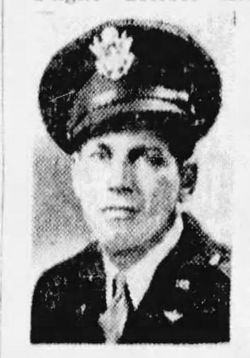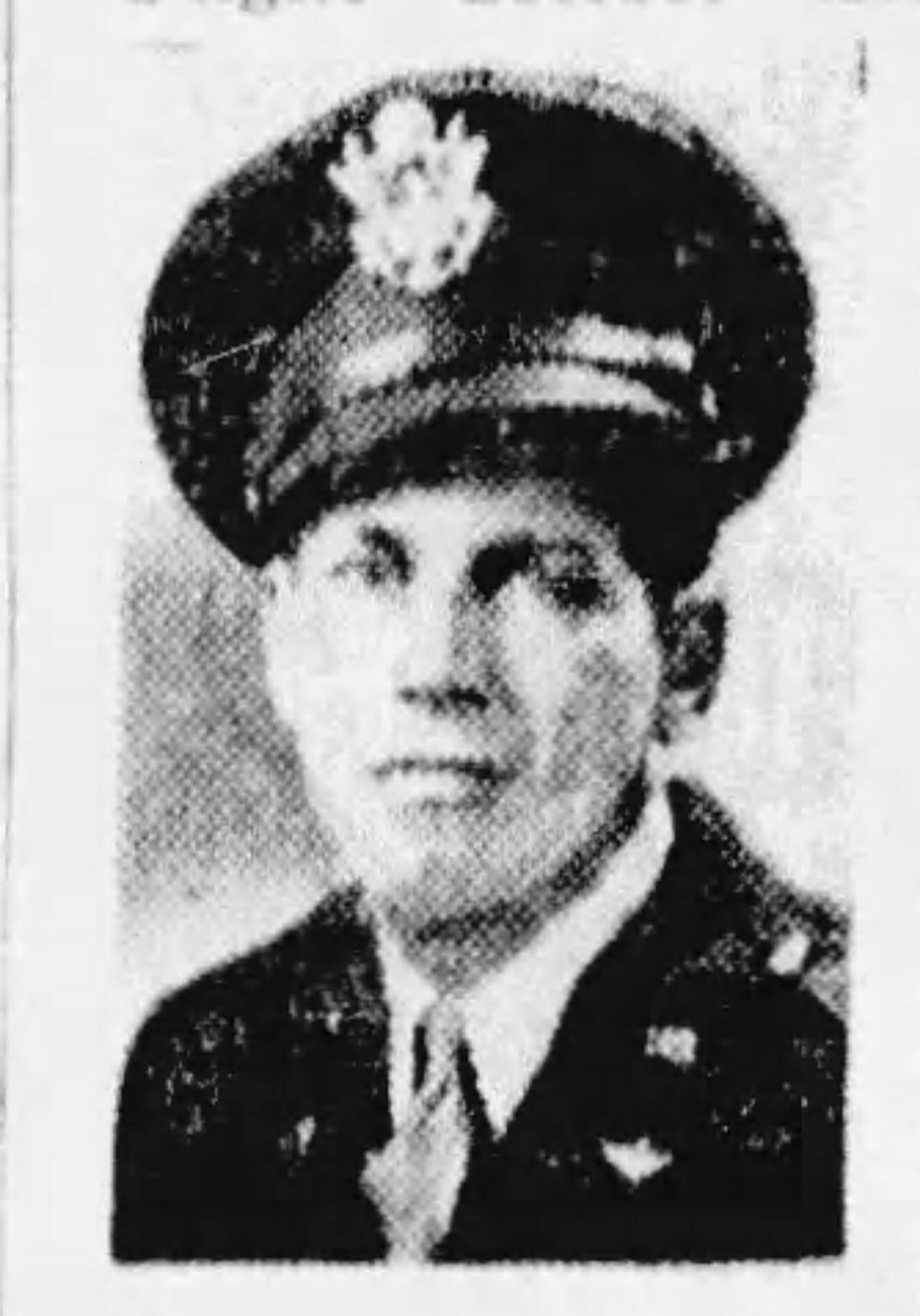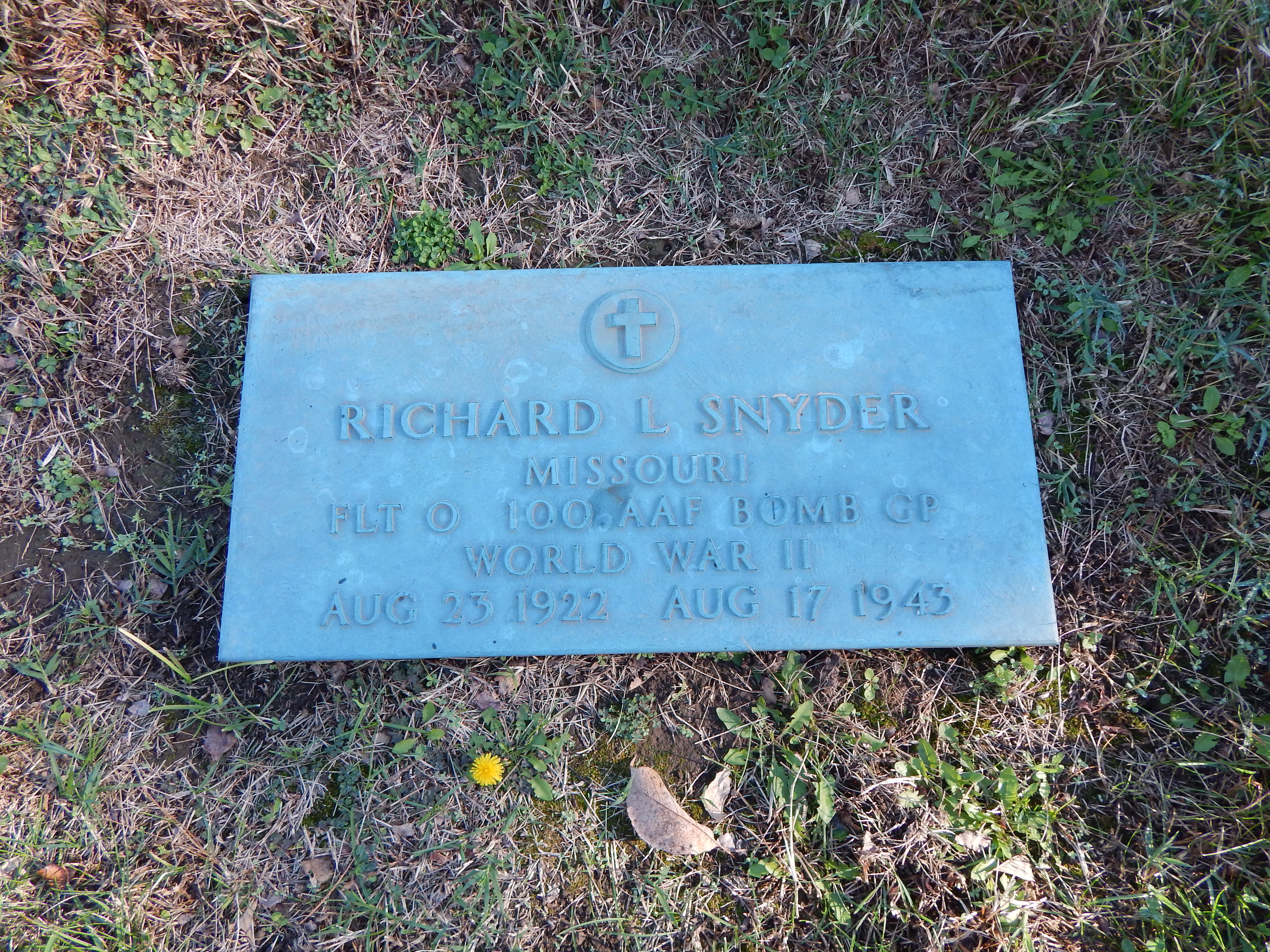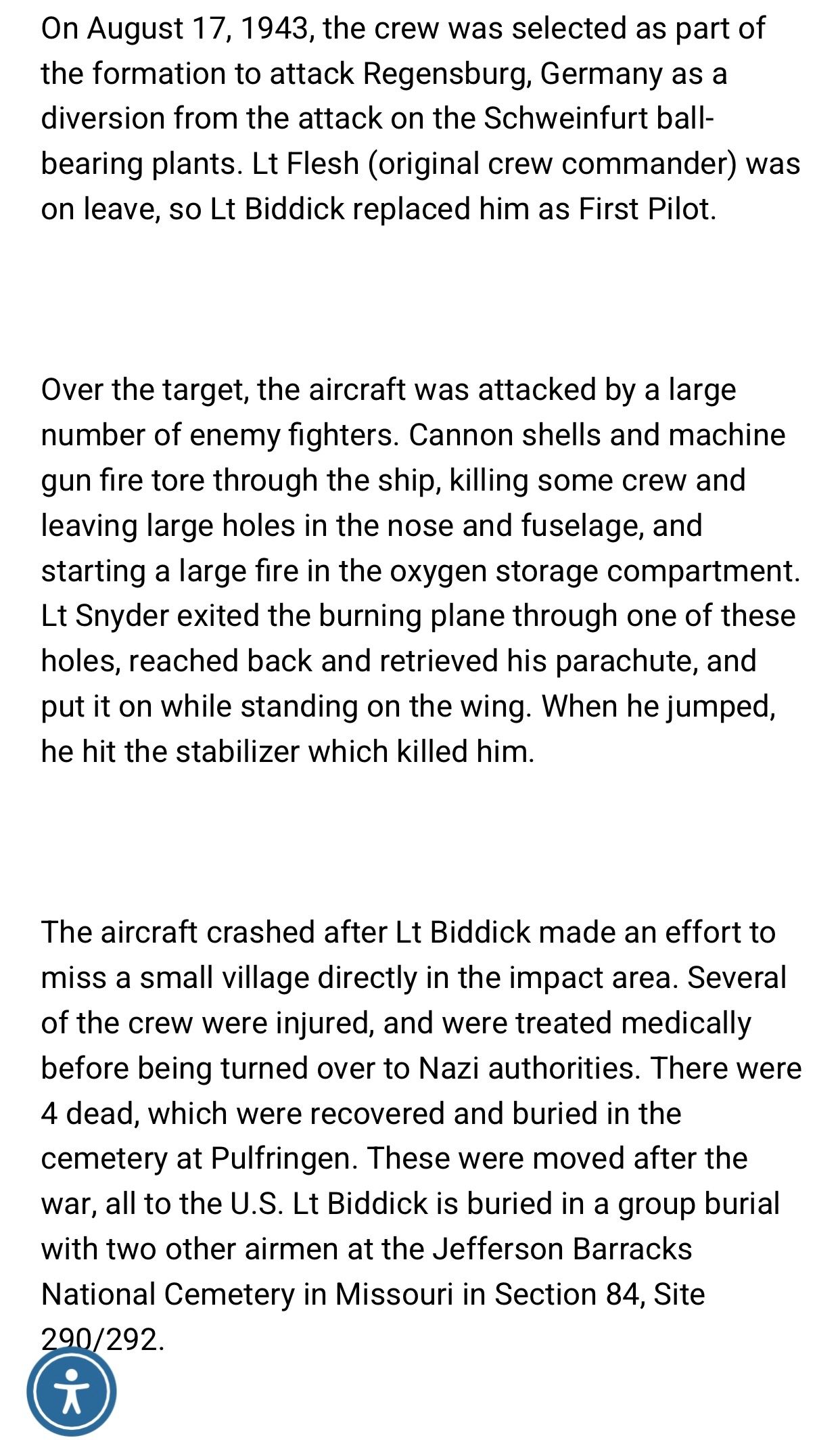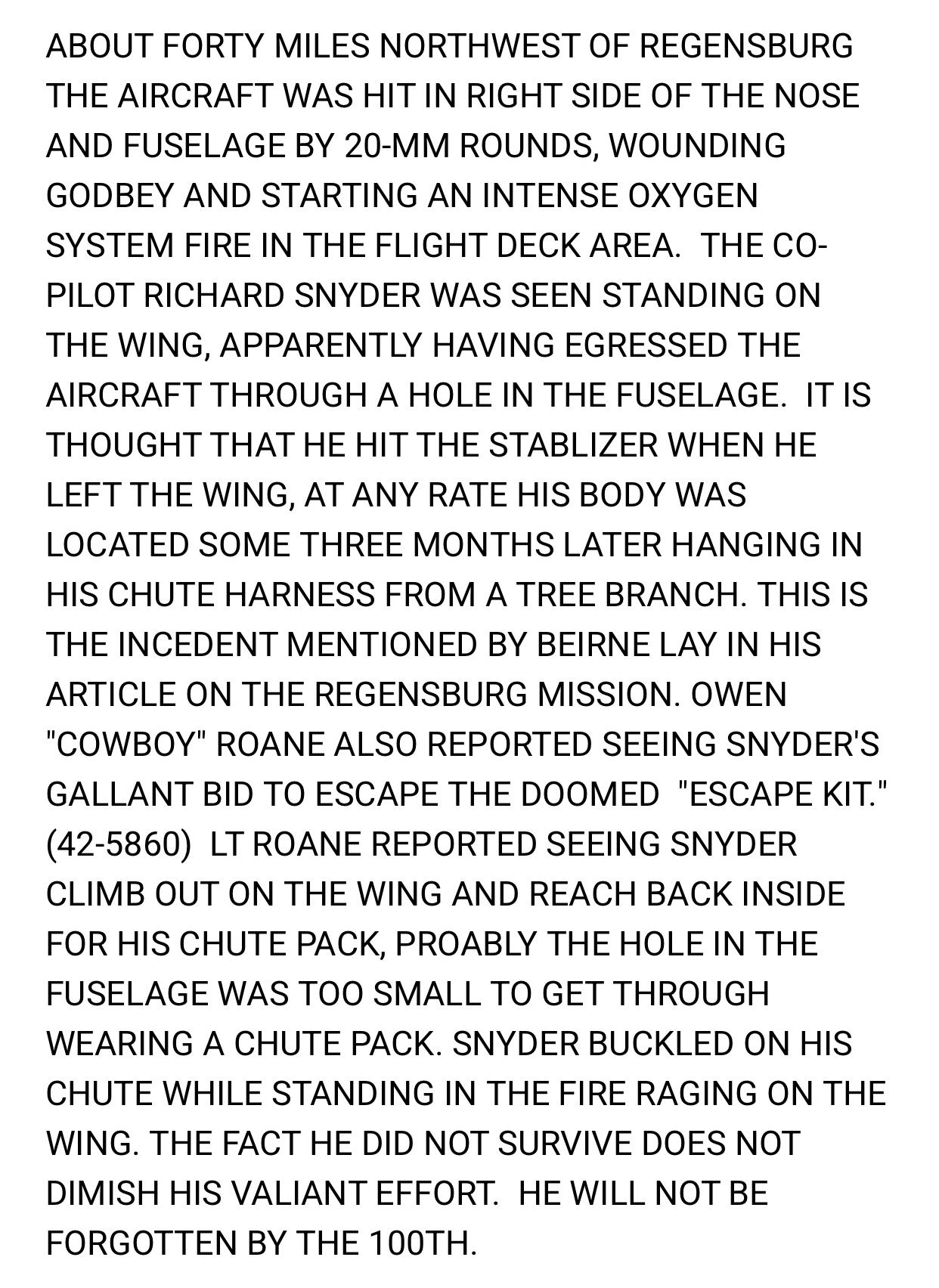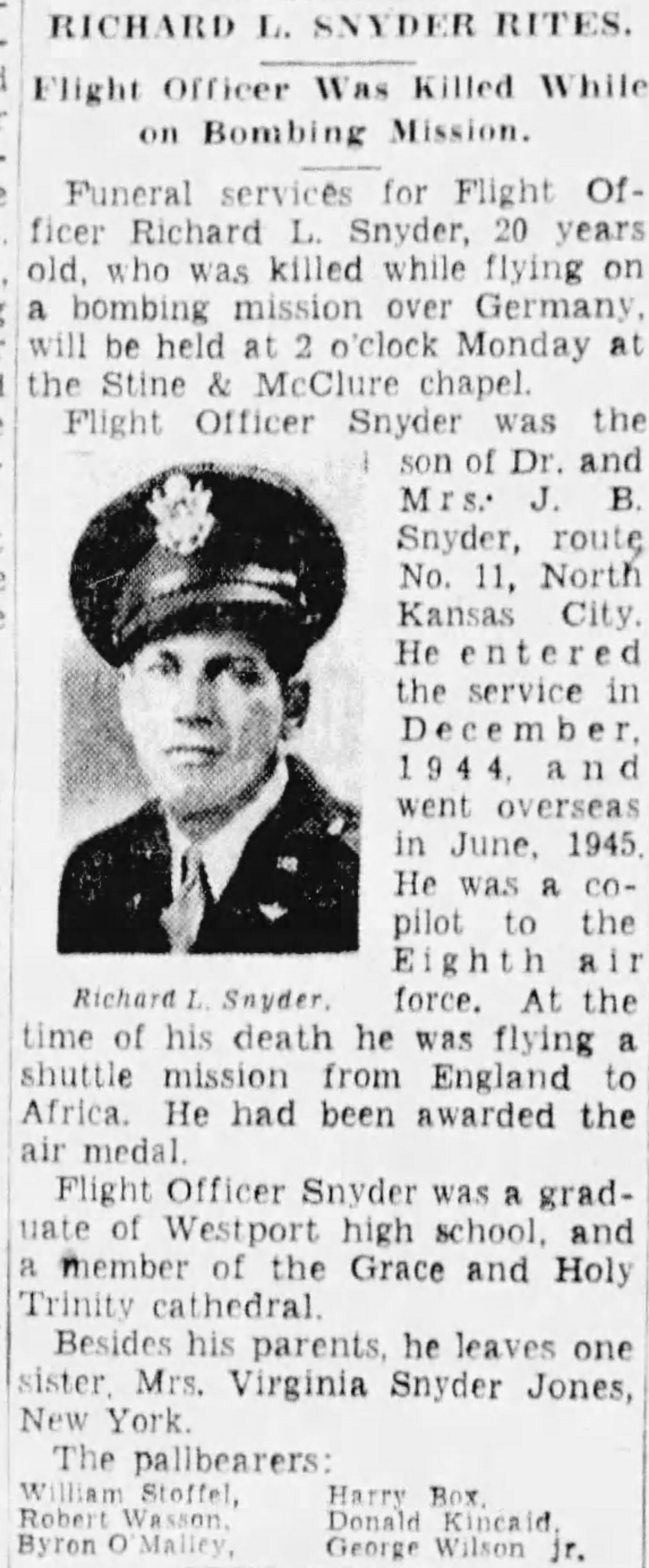https://www.fold3.com/memorial/638569208/richard-l-snyder/stories
F/O Richard L Snyder, 418th Bomb Squadron, 100th Bombardment Group
Richard Lee Snyder was born August 23, 1922 in Kansas City, Jackson County, Missouri to Jesse Beers Snyder, a medical doctor, and Rethel L (Powell) Snyder, both of whom were natives of Indiana. Richard had one younger sister. In 1930, the family was living in Kansas City, where his father worked in the meat packing industry. Richard attended local schools in Kansas City, graduating from Westport High School in 1940, where he was a member of the a capella choir and the boxing team.
Richard enlisted in the US Army Air Corps on 7 December 1940 at Jefferson Barracks, Missouri. His enlistment record indicates he was single, had completed four years of high school, and was working as a sales clerk. Details of his early service could not be found. After the outbreak of World War II and the resulting urgent need for more pilots, the USAAC allowed enlisted men to enter flight training. Richard apparently was selected for flight training and upon completion was designated a Flight Officer, which was equal in status to that of warrant officer junior grade. He was then assigned as a co-pilot to one of the initial crews of the 418th Bomb Squadron of the 100th Bombardment Group (Heavy), Eighth Air Force, which flew B-17 Flying Fortress heavy bombers.
The 100th BG was activated 27 October 1942 at Gowen Field, Idaho then moved to Walla Walla Army Air Base, Washington. After receiving crews and aircraft, the group relocated again on 30 November 1942 to Wendover Field, Utah, where it added additional personnel, aircraft, and crews, and began operational training. On 1 January 1943, the aircraft and aircrews moved to Sioux City AAB, Iowa where they assisted in training of other groups bound for overseas. In mid-April 1943, the aircrews moved to Kearney Army Air Field, Nebraska and received brand new B-17s. After additional operational training, the group's aircrews departed Kearney on 25 May 1943, flying the North Atlantic route to England, where the group was based at Thorpe Abbotts, Norfolk. F/O Snyder was the co-pilot in the crew of B-17F 42-30066, known as "Mug Wump", and completed five combat missions by mid August 1943.
On 17 August 1943, the crew of Mug Wump was flying aboard B-17F 42-5860, known as "Escape Kit", one of 21 aircraft from the 100th BG, along with 125 B-17s from six other groups, tasked to bomb a Messerschmitt aircraft factory in Regensburg, Germany. The mission was part of a two-pronged attack against the factory at Regensburg and the ball-bearing plants at Schweinfurt, Germany, with the Regensburg force landing at airfields in North Africa. To split the German fighter defense, these raids were supposed to occur simultaneously, however, fog delayed the Schweinfurt force's takeoff while the Regensburg force departed on time. As a result, enemy fighters hit the first force, landed, rearmed, refueled, and then engaged the delayed second force.
Without fighter escort for much of the mission, the bombers in both forces faced wave after wave of Luftwaffe fighters. On the approach to the target area, Escape Kit was shot up by enemy fighters, causing an intense oxygen system fire in the flight deck area. The pilot of another aircraft in the formation later reported seeing F/O Snyder climb out of a shattered cockpit window onto the wing, presumably to escape the fire, and then fall away from the aircraft to his death. Escape Kit dropped out of formation, and six members of the crew were able to bail out and became prisoners of war. Besides F/O Snyder, three other crew members were either killed in the air or in the ensuing crash approximately 18 miles southwest of Wurzburg, Germany. In addition to Escape Kit, eight other 100th BG aircraft failed to make it to North Africa. Although the raid caused heavy damage at both factories, 60 of the 376 bombers dispatched were shot down and more than 600 Airmen were killed, missing, or captured.
F/O Richard Lee Snyder was initially buried in a local cemetery in Germany and in 1948 was reinterred in Memorial Park Cemetery in Kansas City, Jackson County, Missouri.
Thank you F/O Snyder for your service and your sacrifice, you will not be forgotten.
~
Killed in action in the Regensburg mission:
1LT Curtis R Biddick, Pilot
TSGT Lawrence E Godbey
SGT James R Bair
FLT O Richard L Snyder
TSGT Robert R DeKay
https://www.fold3.com/memorial/638569208/richard-l-snyder/stories
F/O Richard L Snyder, 418th Bomb Squadron, 100th Bombardment Group
Richard Lee Snyder was born August 23, 1922 in Kansas City, Jackson County, Missouri to Jesse Beers Snyder, a medical doctor, and Rethel L (Powell) Snyder, both of whom were natives of Indiana. Richard had one younger sister. In 1930, the family was living in Kansas City, where his father worked in the meat packing industry. Richard attended local schools in Kansas City, graduating from Westport High School in 1940, where he was a member of the a capella choir and the boxing team.
Richard enlisted in the US Army Air Corps on 7 December 1940 at Jefferson Barracks, Missouri. His enlistment record indicates he was single, had completed four years of high school, and was working as a sales clerk. Details of his early service could not be found. After the outbreak of World War II and the resulting urgent need for more pilots, the USAAC allowed enlisted men to enter flight training. Richard apparently was selected for flight training and upon completion was designated a Flight Officer, which was equal in status to that of warrant officer junior grade. He was then assigned as a co-pilot to one of the initial crews of the 418th Bomb Squadron of the 100th Bombardment Group (Heavy), Eighth Air Force, which flew B-17 Flying Fortress heavy bombers.
The 100th BG was activated 27 October 1942 at Gowen Field, Idaho then moved to Walla Walla Army Air Base, Washington. After receiving crews and aircraft, the group relocated again on 30 November 1942 to Wendover Field, Utah, where it added additional personnel, aircraft, and crews, and began operational training. On 1 January 1943, the aircraft and aircrews moved to Sioux City AAB, Iowa where they assisted in training of other groups bound for overseas. In mid-April 1943, the aircrews moved to Kearney Army Air Field, Nebraska and received brand new B-17s. After additional operational training, the group's aircrews departed Kearney on 25 May 1943, flying the North Atlantic route to England, where the group was based at Thorpe Abbotts, Norfolk. F/O Snyder was the co-pilot in the crew of B-17F 42-30066, known as "Mug Wump", and completed five combat missions by mid August 1943.
On 17 August 1943, the crew of Mug Wump was flying aboard B-17F 42-5860, known as "Escape Kit", one of 21 aircraft from the 100th BG, along with 125 B-17s from six other groups, tasked to bomb a Messerschmitt aircraft factory in Regensburg, Germany. The mission was part of a two-pronged attack against the factory at Regensburg and the ball-bearing plants at Schweinfurt, Germany, with the Regensburg force landing at airfields in North Africa. To split the German fighter defense, these raids were supposed to occur simultaneously, however, fog delayed the Schweinfurt force's takeoff while the Regensburg force departed on time. As a result, enemy fighters hit the first force, landed, rearmed, refueled, and then engaged the delayed second force.
Without fighter escort for much of the mission, the bombers in both forces faced wave after wave of Luftwaffe fighters. On the approach to the target area, Escape Kit was shot up by enemy fighters, causing an intense oxygen system fire in the flight deck area. The pilot of another aircraft in the formation later reported seeing F/O Snyder climb out of a shattered cockpit window onto the wing, presumably to escape the fire, and then fall away from the aircraft to his death. Escape Kit dropped out of formation, and six members of the crew were able to bail out and became prisoners of war. Besides F/O Snyder, three other crew members were either killed in the air or in the ensuing crash approximately 18 miles southwest of Wurzburg, Germany. In addition to Escape Kit, eight other 100th BG aircraft failed to make it to North Africa. Although the raid caused heavy damage at both factories, 60 of the 376 bombers dispatched were shot down and more than 600 Airmen were killed, missing, or captured.
F/O Richard Lee Snyder was initially buried in a local cemetery in Germany and in 1948 was reinterred in Memorial Park Cemetery in Kansas City, Jackson County, Missouri.
Thank you F/O Snyder for your service and your sacrifice, you will not be forgotten.
~
Killed in action in the Regensburg mission:
1LT Curtis R Biddick, Pilot
TSGT Lawrence E Godbey
SGT James R Bair
FLT O Richard L Snyder
TSGT Robert R DeKay
Inscription
MISSOURI
FLT O 100 AAF BOMB GP
WORLD WAR II
Family Members
Other Records
Sponsored by Ancestry
Advertisement
Records on Ancestry
Advertisement
